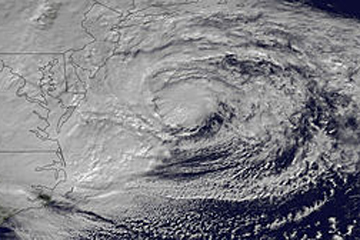Hurricane Sandy Brought Surge in Carbon Monoxide Poisonings

The devastation following Hurricane Sandy's battering of the U.S. East Coast one year ago was enormous. The superstorm destroyed or damaged thousands of homes, closed businesses and the New York Stock Exchange, flooded the subway system, and even wiped out years of biomedical research at universities.
Less publicized, however, was a disturbing public health threat seen in emergency rooms across the New York area following Sandy and the nor’easter that rolled in just days later: carbon monoxide poisoning.
A study published this month by researchers at the New York City Poison Control Center in the journal Clinical Toxicology reveals a spike of 437 cases of suspected carbon monoxide poisoning reported in emergency rooms of the city's hospitals during the two weeks following Sandy.
To put that number in context, the total number of reported carbon monoxide exposures in the greater New York area for the same two-week period between 2008 and 2012 was only 116, according to the study. [Weirdo Weather: 7 Rare Weather Events]
Although Sandy brought a huge increase, the spike was not unprecedented. As many as 75 deaths and 2,000 non-fatal poisonings were reported from various regions following hurricanes, floods and winter storms since 1994, according to a previous report from scientists at the Centers for Disease Control and Prevention. Some of the largest spikes reported were from ice storms in Kentucky in 2009, Hurricane Ike in 2008 and Hurricane Katrina in 2005.
The New York City researchers said the spike in poisonings after Sandy serves as a reminder about the dangers of carbon monoxide released from portable generators and heating elements after big storms during power outages.
Carbon monoxide, the great imitator
Get the world’s most fascinating discoveries delivered straight to your inbox.
A colorless, odorless gas, carbon monoxide is undetectable by human senses and poisoning cases are difficult to diagnose. Dr. Steven Marcus, executive director of the New Jersey Poison Education and Information System, who was not involved in the study, said carbon monoxide poisoning is "a great imitator," meaning that its symptoms resemble those of many other conditions. People might experience headaches, muscular aches and lethargy, he said.
If the exposure goes on too long, coma and death can occur, Marcus told LiveScience.
Carbon monoxide is harmful because it interferes with the body's ability to use oxygen. Molecules of carbon monoxide occupy the spot on hemoglobin molecules where oxygen is usually carried, but carbon monoxide binds to hemoglobin 250 times more efficiently than oxygen.
If poisoning is suspected, Marcus said he recommends getting fresh air immediately. If the exposure is prolonged and symptoms are severe, oxygen treatment might be required.
The CO source
A spike in poisonings seen after Hurricane Sandy might not seem obvious -- after all, the storm didn't blow in carbon monoxide. The culprit here, Marcus said, is people ignoring warnings and putting themselves at risk.
Major sources of carbon monoxide after weather-related disasters are fuel-burning generators, gas grills and kerosene lamps. When used correctly, and in properly ventilated spaces, portable generators offer a safe source of power, heat and light.
But problems arise when generators and heaters are used in small, confined spaces too close to living quarters. Power outages were widespread in the days after Hurricane Sandy, and many people resorted to heating their homes using ovens and charcoal grills, adding the risk of fire in addition to the danger of carbon monoxide.
Marcus said portable generators should be kept at least 25 feet from living spaces, and that carbon monoxide monitors be installed.
The good news is the study found no deaths due to carbon monoxide after Sandy. The authors said this was a result of a well-coordinated public awareness campaign about the dangers of carbon monoxide that included radio announcements from New York Mayor Michael Bloomberg, the education of physicians about symptoms, and the existing requirements for carbon monoxide alarms in New York. In fact, many of the exposures reported to authorities came from homes in which alarms had been activated, the researchers said.
Follow LiveScience @livescience, Facebook & Google+. Original article on LiveScience.


